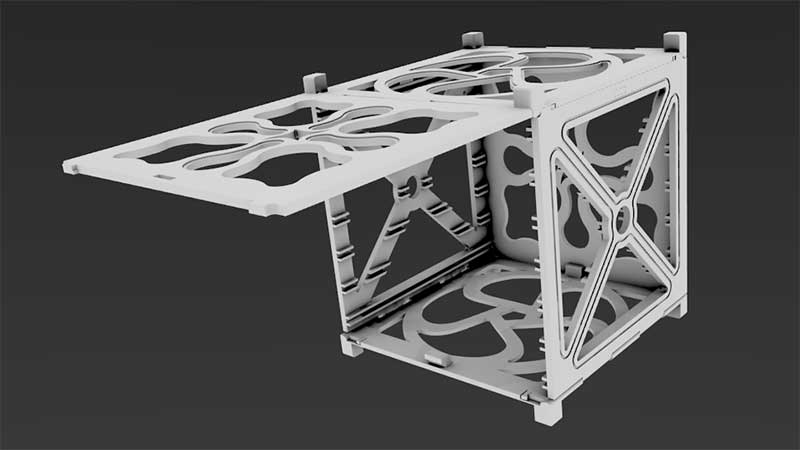The winners are in for the GrabCad CubeSat Challenge, which asked designers to rethink the way that CubeSats are built. These tiny 10 cm square satellites are the hot thing in orbit, and the competition was looking for new ways to build and pack more into this tiny space. The winners offered some fascinating new approaches to building CubeSats, and some excellent design lessons that anyone can use.
The winner was FoldSat, by [Paolo Minetola]. His excellent design is a 3D printed folding case for a satellite that is built from just two 3D printed parts. The case can be snapped together and offers multiple ways to mount electronic components and sensors inside. [Paolo] estimates that it could save 40% time and 30% materials from existing CubeSat casings, which means more space inside and more time to build. It is an excellent example of how 3D printing can make things cheaper, easier and better, all at the same time.
My personal favorite was the eighth place Cube Brick from [Ridwan Septyawan], which uses a series of stackable PCB holders to make the cube. It’s like a Lego set for orbit, or an Ikea bookshelf for space: Each of the layers snaps into the one below, creating a firm hold without using screws or bolts. With a maximum weight of 1.6kg (about 3.5lbs), every little bit counts on a CubeSat, so [Ridwan’s] minimal but strong design might be the thing that allows you to squeeze another sensor onto your next space probe.
All of the winners have their own merits, and anyone who has struggled to build something to a tight target weight or size will appreciate the inventiveness they offer. Hopefully, we will see some of them in orbit soon, alongside other CubeSats like the amateur radio satellite SO-50, currently speeding through the skies above your head.
















Yes
Are there any companies that would be able to get a cubeSat into a stable orbit? I’ve always wanted build one with a couple FPGAs, some processors (Or maybe even get some space-rated Zynq chips to take care of both), some SDR chips, some highly-adjustable antennas (Maybe use some form of liquid metal…) and a bunch of flash. That way I could use it for whatever I want, I just upload some new VHDL to change its role, or to complete update it when new technologies come around.
If im not mistaken, cubesats are put into orbit all the time. And the reason their orbits arent “stable” is because the cubes dont have flight controls to adjust their orbit as needed. But, I could be wrong.
They are deliberately placed into low altitude orbits, hence the shorter life. Attitude won’t hurt the orbit much on CubeSats anyway. This is to not just keep launch costs down, but more like to avoid congestion of dead satellites out of student projects, leading to the Kessler Syndrome.
CubeSats in high and stable orbits do exist, though they are mostly earlier birds(literally) launched as primary payload before the form factor have become popular. Obviously if you have enough time and funding it is always possible to launch any mission into any orbit.
Got deep pockets? According to AMSAT $100k to get a cube sat into LEO. $10 million to get something into HEO at current quotes.
I would assume those prices are a minimum-cost-to-orbit calculation for a single payload rather than a per-payload cost. So if you wanted to, it wouldn’t take that much more to launch a hundred cubes. Attach a solar sail on each, and you could afford to launch 100 or more at a time, give them slightly different thrust vectors during deployment and let them drift into varying orbits, potentially allowing the constellation to cover the entire planet in a single launch and a couple months of maneuvering. Since solar sails don’t require propellant, and using SuperCaps for primary energy storage, the satellites could take all the time they want to get on-station and stay there until something damages them or the electronics finally go.
Not a single one is optimized to lower the radiations inside. I would also be suspicious on dimensional tolerances…
Other than that there is a lot of interesting design but maybe not that good for space…
First hit for “launch costs” of a CubeSat suggests USD30000 to USD40000 per kg. For these prices saving a bit of time on final assembly is probably not your biggest concern and al those fancy curves are also a waste of material = weight = money.
Indeed, once its on the rocket and the door is closed, it’ll never be seen again, so why make it pretty? I do like the idea of making satellite casings out of light-weight plastics, specifically so that it doesn’t do too much damage if it hits into something, well not as much as if it was made with aluminium.
Oh, 3D printing, is there nothing you can’t do?
3d printing is for modeling not for make the cube sat it self!! … so after you modeling how the cubesat will be you will have to make it with something that will not melt or crack in heat and cold.. of orbiting in space.. also the structure and the electronics , must past some test! and you have to keep structure strong in any condition , and the batteries stable in a nice +temp away up from zero …. and you have to make also a pcb for electric solar power management… 3d printing is not an option yet … only for modeling the cubesat and the pcbs
Watch AMSAT’s Fox Labs Live Stream!
https://www.youtube.com/c/n0jy/live